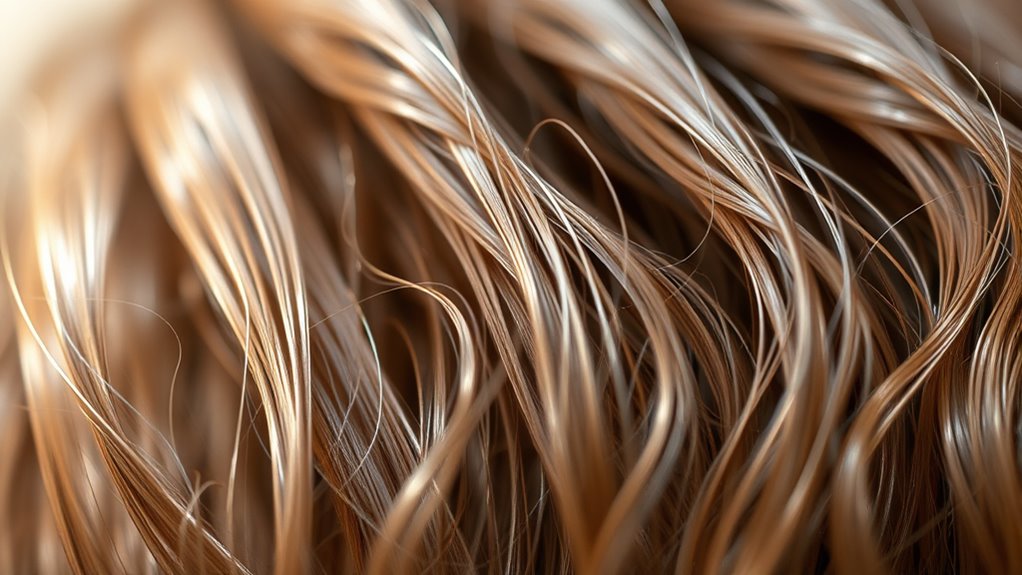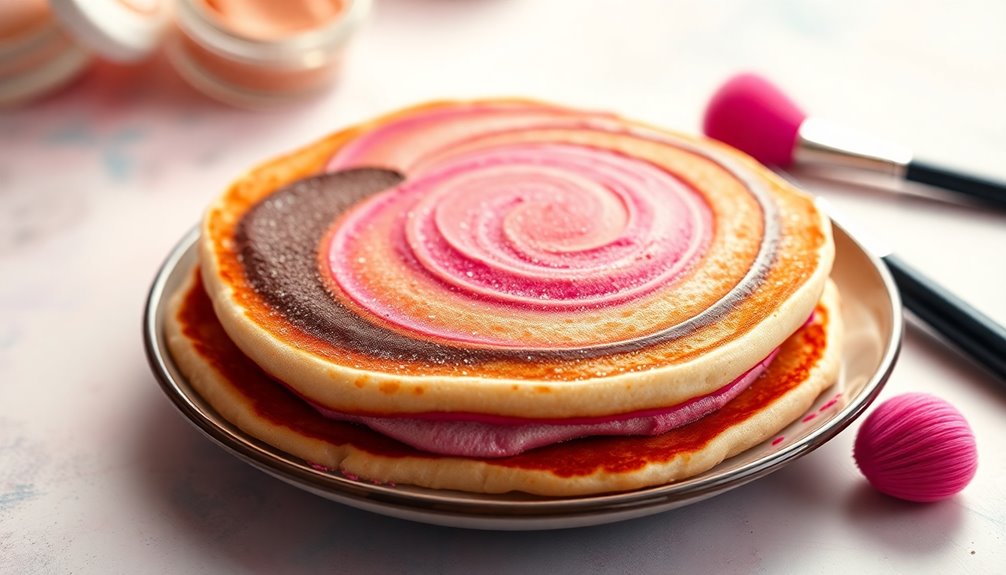Understanding your hair’s porosity helps you figure out how well your hair absorbs and holds moisture, which impacts your product choices and styling methods. Low porosity hair resists moisture, so lightweight products and heat help open cuticles. High porosity absorbs quickly but loses moisture fast, so sealing with oils is key. Medium porosity balances absorption and retention. Recognizing your porosity lets you customize your routine for healthier, more manageable hair—if you keep exploring, you’ll learn even more.
Key Takeaways
- Hair porosity indicates how well hair absorbs and retains moisture, affecting product absorption and longevity.
- Different curl patterns are linked to porosity levels, with tightly coiled hair often having higher porosity.
- There are three main porosity types: low, medium, and high, each requiring specific hair care strategies.
- Understanding porosity helps tailor products, routines, and treatments to prevent issues like buildup or dryness.
- Proper assessment of porosity promotes healthier, more manageable hair by optimizing moisture retention and product use.

Hair porosity refers to how well your hair can absorb and retain moisture, and understanding it is vital to maintaining healthy, manageable hair. Your hair’s porosity affects how quickly it takes in water and products, as well as how long it holds onto moisture. Recognizing your porosity type helps you choose the right hair care routine, products, and styling techniques, leading to healthier, more vibrant hair. While porosity might seem complicated, it’s actually closely linked to your curl pattern, as different curl types often correlate with specific porosity traits, but they’re not the same. For example, tightly coiled or kinky hair tends to have higher porosity because the cuticles are more raised or damaged, allowing moisture to escape easily. Conversely, straight or loosely curled hair often has lower porosity, with cuticles lying flat, making it harder for moisture to penetrate but better at retaining it once absorbed. Understanding these porosity types helps you adapt your routine accordingly.
There are generally three porosity types: low, medium, and high. Low porosity hair has tightly bound cuticles, which makes it resistant to moisture absorption. If your hair falls into this category, you might notice products sitting on the surface without fully penetrating, leading to product buildup and dullness. To improve absorption, you should focus on light, water-based products and consider using heat when conditioning, which helps open the cuticles. Medium porosity hair is often considered the easiest to manage because its cuticles are slightly raised, allowing moisture in and keeping it well-retained. With medium porosity, you can usually follow a balanced routine, using both heavier and lighter products as needed. High porosity hair, on the other hand, has widely spaced or damaged cuticles, making it absorb moisture quickly but also lose it just as fast. If your hair feels dry, brittle, or tangles easily, high porosity is likely. To care for high porosity hair, you’ll want to focus on sealing moisture with heavy creams or oils after moisturizing, as well as avoiding harsh chemical treatments that can worsen damage.
Understanding your porosity type and how your curl pattern interacts with it empowers you to tailor your hair care routine. Whether you have tightly coiled curls or loose waves, recognizing your specific porosity helps you make smarter choices about products, washing frequency, and styling techniques. Additionally, properly assessing porosity can prevent common issues like product buildup or excessive dryness, leading to healthier hair in the long run. This knowledge guarantees your hair gets the right amount of moisture, remains healthy, and is easier to manage. Ultimately, understanding your hair’s porosity is a vital step toward achieving the luscious, manageable locks you desire, regardless of your curl pattern.
Frequently Asked Questions
How Often Should I Test My Hair’s Porosity?
You should test your hair’s porosity every few months to maintain ideal hair health. Regular porosity testing helps you understand how your hair responds to products and treatments, ensuring you adjust your routine accordingly. If you notice changes in moisture retention or product absorption, it’s a good sign to do another test. Staying on top of porosity testing keeps your hair healthy, hydrated, and looking its best.
Can Hair Porosity Change Over Time?
A wise saying goes, “Change is the only constant.” Hair porosity can indeed change over time due to factors influencing porosity, like heat styling, chemical treatments, or environmental exposure. Your hair porosity evolution reflects these influences; it may become more or less porous. Regular assessments help you adapt your hair care routine, ensuring your hair stays healthy regardless of its changing porosity.
Does Hair Porosity Affect Hair Color Treatments?
Yes, hair porosity affects hair color treatments. If your hair has high porosity, it absorbs dye quickly but may also lose color faster, impacting dye longevity. Low porosity hair resists dye absorption, making it harder to achieve vibrant color and potentially reducing color longevity. By understanding your hair’s porosity, you can choose the right products and techniques to enhance hair color absorption and maximize dye longevity.
Which Hair Types Are Most Prone to High Porosity?
You’ll find that curly and wavy hair types are most prone to high porosity, with over 60% of these textures experiencing it. Porosity often correlates with curl pattern, as tighter curls can leave hair cuticles more open. Additionally, high porosity impacts scalp health by allowing moisture loss and dirt buildup. If you have loose or straight hair, your porosity is usually lower, leading to different care needs.
How Does Hair Porosity Influence Product Choice?
Your hair’s porosity greatly influences your product choices. High porosity hair tends to lose moisture quickly, so you should opt for heavier conditioners and sealing oils to improve moisture retention. Low porosity hair, on the other hand, may need lighter products to prevent buildup. Additionally, understanding porosity helps you maintain scalp health by choosing products that balance moisture without clogging follicles. Tailoring your routine based on porosity keeps your hair healthy and well-moisturized.
Conclusion
Now that you understand hair porosity, you can confidently care for your curls. Recognize the ripeness of your roots, rinse with intention, and regulate your routines. By mastering moisture management and minimizing damage, you’ll maintain healthy, happy hair. Remember, porosity’s power lies in your hands—patience, practice, and proper products pave the path to perfect hair. So, stay savvy, stay strong, and let your locks shine with lively, luscious life!










